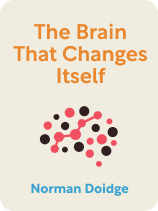

This article is an excerpt from the Shortform book guide to "The Brain That Changes Itself" by Norman Doidge. Shortform has the world's best summaries and analyses of books you should be reading.
Like this article? Sign up for a free trial here.
What is the critical period of brain development? At what age does the brain become set in stone? Can structural changes happen in the brain after the critical period is over?
During the critical period, unused parts of the brain can change themselves to perform functions different from their original functions. In the past, the belief was that once this critical period was over, the brain was set in stone. However, we now know that the brain retains its potential for structural change.
Here’s why the brain doesn’t become set in stone once the critical period is over.
The Critical Period of Brain Development
The critical period of brain development is a span of time in infancy when our brains are absorbing immense amounts of information and developing connections at an extremely high rate. This is the period when our brain maps are first being built.
(Shortform note: There are actually several critical periods of brain development that humans go through throughout their childhoods. The human brain develops rapidly even while we’re in the womb, as a pregnant person’s stress levels have been shown to impact their fetus’s brain development—further evidence that the brain continues to develop and isn’t set in stone.)
Scientists David Hubel and Torsten Wiesel discovered the critical period by using electrodes to study the development of the visual cortex in kittens. When they sewed one eyelid shut during the kitten’s critical period (three to eight weeks), then later unsewed it, they found that the brain map for vision in that eye never developed—the cat remained blind in that eye for the rest of its life. However, they also found that the part of the cortex that would have processed input from the shut eye rewired itself to process input from the eye that was left open. This showed that the brain was capable of structural change, or plasticity, but Hubel and Wiesel believed that this plasticity ended once the critical period was over, and that the brain maps were then hardwired for the rest of the creature’s life.
(Shortform note: Hubel and Wiesel’s experiments showed that sensory deprivation during the critical period could keep a sense from developing at all, but new research suggests sensory deprivation can also be used in adulthood to restore a sense that didn’t develop correctly. In another experiment using kittens, specifically those with impaired or lost vision in one eye, scientists found that immersing the kittens in total darkness for ten days caused their visual centers to revert to a level of plasticity similar to the critical period, allowing them to regain their vision in the impaired eye. Researchers believe this is because the nonuse of the visual system for ten days destabilized the established visual system, allowing it to rebuild itself completely.)
However, further studies involving brain mapping showed that brain maps constantly change, even without interventions like removing input from a sense or part of the body. Mapping an animal once and then doing so again months later showed changes in the maps every time, indicating that our brains change in the normal course of our lives.
(Shortform note: Early maps showed us the location of things like bodily functions and sensory perception and processing in the brain, but more recent research has allowed us to pinpoint where newly-learned concepts appear in the brain. Studies showed that when a group of people all learned the same new concept, the same regions of their brains were activated, showing exactly where that learning was taking place. Not only was this a big step forward from just mapping functions and sensory processing, it also showed that everything we learn causes permanent changes to our brains—which helps explain why repeated brain scans show that maps are constantly changing.)
One experiment using monkeys showed that the brain wasn’t “hard-wired” to have a specific structure, indicating that the brain must be plastic. In the experiment, scientists disconnected the monkey’s nerves that control their thumb and forefinger, then reversed them. But the nerves reorganized themselves so that the monkey could still control its thumb and forefinger just as well as before.
Additional research led to the discovery of competitive neuroplasticity. According to Doidge, this means if a nerve stops working (is cut), the area of the brain that is connected to that nerve doesn’t just waste away. Instead, since the brain only has so much mass to perform all its different functions, the nerves that still work will use that leftover brain space, showing that there’s competition for limited resources within the brain. If you don’t use an area of the brain for its original purpose, it may be taken over by other functions you do still use.
To discover this, researchers again used monkeys as test subjects: They disconnected the nerve that controls the middle of the hand, or the median nerve, so that it wouldn’t receive any input from the middle of the hand. As expected, when the middle of the monkey’s hand was touched, the brain area connected to the median nerve no longer lit up. However, touching other areas of the monkey’s hand that were controlled by different nerves did cause that brain area to light up, meaning that brain area was now being used to detect input from those other nerves.
| Competitive Plasticity and Human Development Competitive brain plasticity may help explain why humans lack certain senses that other animals have, such as infrared vision or ultrasonic hearing. If these skills weren’t necessary for our survival, our brains never made space for them, so our species never developed them. Humans have greater cognitive capacity—and often larger brains proportional to our body weight—than animals and therefore need more bodily resources to sustain that cognitive capacity. This higher cognitive capacity and the large brains required to store it may also explain why humans are born helpless compared to so many other creatures. While some animals like horses and chickens are able to stand and walk immediately after birth, human babies are born so weak they can’t even lift their heads. Scientists believe this is because of different gestational periods—while horses, for example, are pregnant for 11-12 months, human infants must be born around the nine-month mark in order for their heads to fit through the birth canal, which is smaller in humans because we’re bipedal. Additionally, being pregnant increases a person’s metabolic needs, and research suggests that a human’s metabolism wouldn’t be able to sustain a fetus past nine months of pregnancy. Therefore, our high cognitive capacity requires much more development post-birth compared to most other animals. |

———End of Preview———
Like what you just read? Read the rest of the world's best book summary and analysis of Norman Doidge's "The Brain That Changes Itself" at Shortform.
Here's what you'll find in our full The Brain That Changes Itself summary:
- How brain plasticity can help those with brain damage or congenital brain disorders
- Stories of real people whose lives have improved thanks to neuroplasticity
- A look at some of the negative effects neuroplasticity can have







This period is crucial for the development of various cognitive, emotional, and sensory abilities. Different regions of the brain have their own critical periods, during which they are particularly responsive to environmental influences.
For example, in language development, there’s a critical period during early childhood when the brain is highly receptive to learning languages. If a child is exposed to multiple languages during this time, they are more likely to become fluent speakers. However, if this window of opportunity passes without exposure to language, it can be more challenging to attain native-like proficiency later in life.